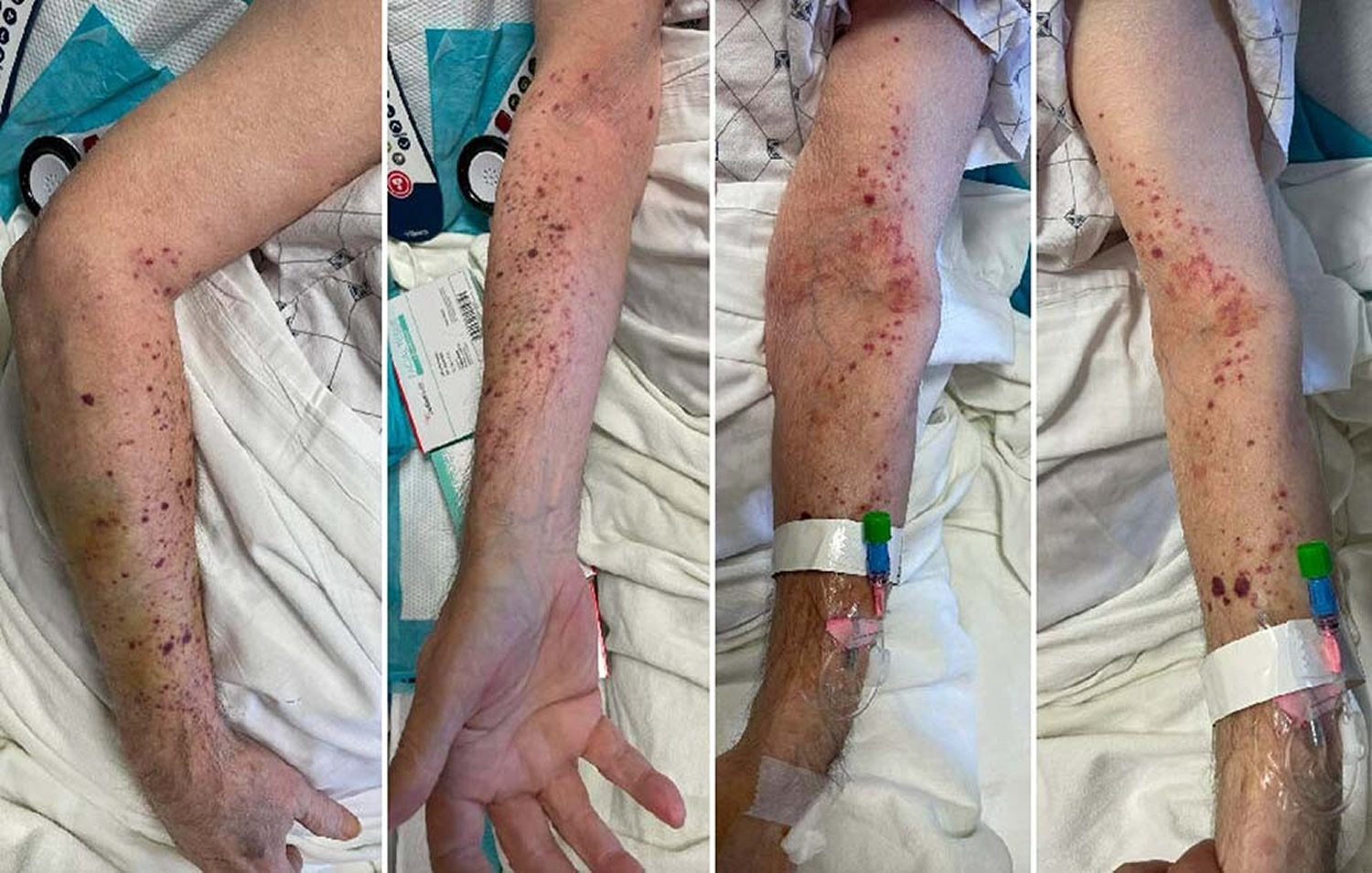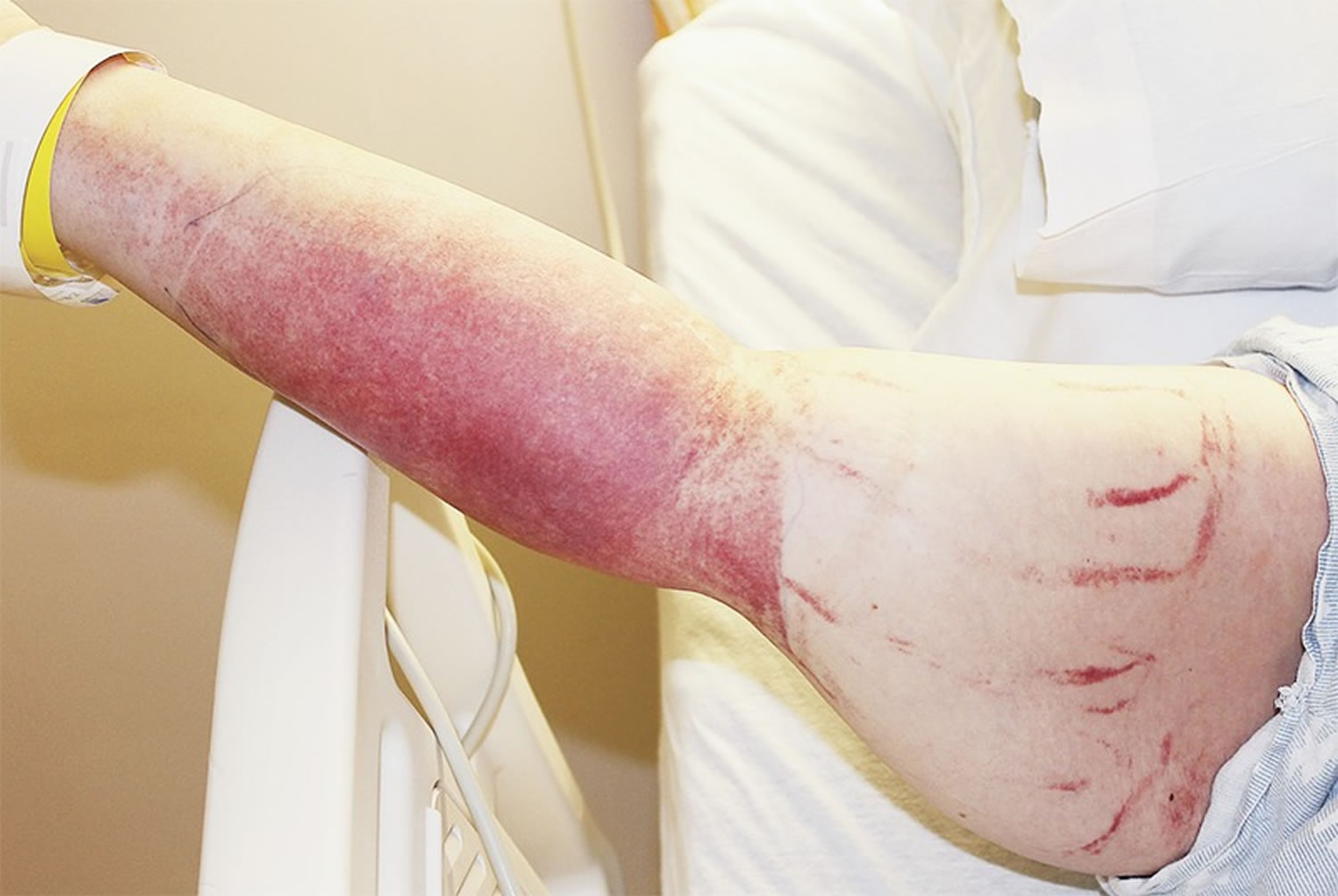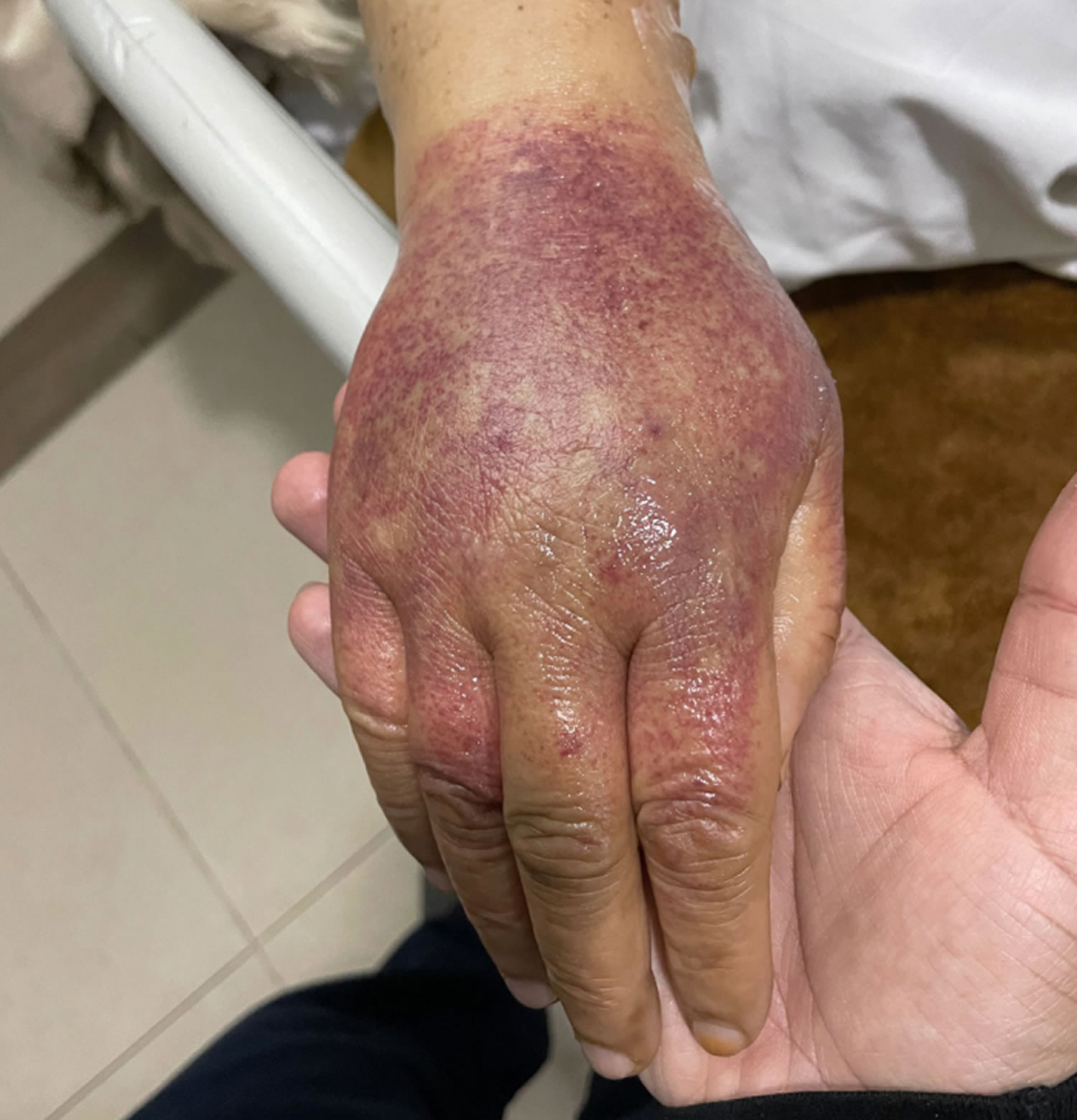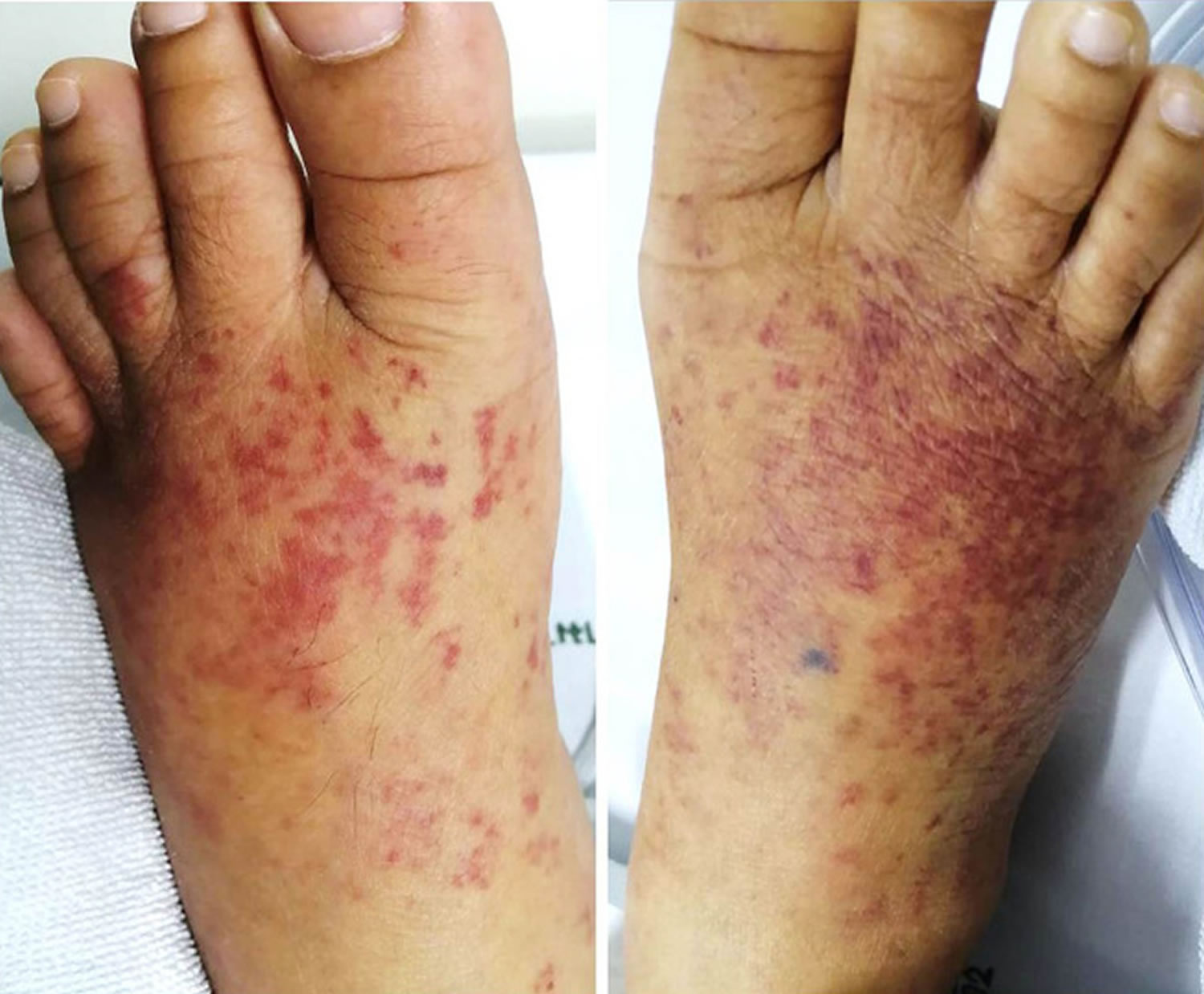Rumpel-Leede Phenomenon
Rumpel-Leede phenomenon also known as Rumpel-Leede sign or acute capillary rupture syndrome, is a rare clinical entity characterized by the acute development of non-blanchable purpuric macules that are caused by dermal capillaries being ruptured in response to a proximal compressive force, such as a blood pressure cuff or tourniquet 1, 2. Rumpel-Leede phenomenon results in a self-limiting nonpurpuric rash that resolves spontaneously without intervention. Most cases resolved spontaneously within two weeks without any specific treatment. Rumpel-Leede phenomenon prevalence remains unknown, with rarely reported cases in the literature 3. The condition was first described in 1909 in a patient with scarlet fever who had petechiae on the arm distal to the tourniquet area for blood pressure monitoring 1. The term was originally coined from the Rumpel–Leede Capillary-Fragility Test, also known as the tourniquet test, which is used for capillary fragility assessment and to assess patients for thrombocytopenia 4. Today, the Rumpel–Leede sign may be observed iatrogenically in the context of continuous blood-pressure monitoring, particularly in patients with bleeding diatheses (an increased susceptibility to bleeding or bruising).
The Rumpel-Leede phenomenon has been previously described under various conditions with diabetes mellitus, diabetes insipidus, hypertension, chronic renal failure, collagen vascular diseases like systemic lupus erythematosus (SLE), nutritional deficiencies such as scurvy, liver disease, leukemia, use of antiplatelets or anticoagulants, long-term steroid use and thrombocytopenia having been demonstrated to be associated with Rumpel-Leede phenomenon 5, 3, 2, 6, 7, 8.
Figure 1. Rumpel-Leede sign
[Source 1 ]Figure 2. Rumpel-Leede phenomenon
Footnote: Purpuric rash, nonpalpable and nonblanching with pressure
[Source 9 ]Figure 3. Rumpel-Leede phenomenon
Footnote: Multiple non-blanchable erythematous macules and patches on both dorsa of feet.
[Source 3 ]The Rumpel-Leede phenomenon is commonly reported to occur after iatrogenic events, especially continuous blood pressure monitoring. The majority of cases were women, all of whom demonstrated a non-blanchable, petechial, or purpuric rash, distributed distally to the device band or cuff. The sphygmomanometer was the most commonly used device 10, 11, 12. Others included the tourniquet 2, radial arterial wristband 9, peritoneal insufflation during laparoscopic abdominal surgery 13, knee stocking 14, cloth material 15 and car seat 16. All cases showed spontaneously improved after discontinuing the causative device, and there were no long-term complications 3.
The diagnosis of Rumpel-Leede phenomenon is based on patient history, clinical findings, and a self-limiting course after removal of the causative device.
Recognition of Rumpel-Leede phenomenon could help avoid unnecessary investigations and invasive diagnostic procedures. However, there is no specific treatment for Rumpel-Leede phenomenon. Cessation of the causative device, along with reassurance of the patient, are recommended.
References- Wang K, Lee J. Images in clinical medicine. Rumpel-Leede sign. N Engl J Med. 2014;370(1):e1. doi: 10.1056/NEJMicm1305270
- Lambdin JT, Mackenzie C. Rumpel-Leede phenomenon in a patient with adult-onset Still’s disease. BMJ Case Rep. 2017 Jan 27;2017:bcr2016217290. doi: 10.1136/bcr-2016-217290
- Ploydaeng M, Jurairattanaporn N, Suchonwanit P, Rattananukrom T. Rumpel-Leede Phenomenon Associated with Pneumatic Compression: A Case Report. Clin Cosmet Investig Dermatol. 2022 Oct 28;15:2323-2327. doi: 10.2147/CCID.S386426
- Chester MW, Barwise JA, Holzman MD, Pandharipande P. Acute dermal capillary rupture associated with noninvasive blood pressure monitoring. J Clin Anesth. 2007 Sep;19(6):473-5. doi: 10.1016/j.jclinane.2006.12.010
- Varela D, Tran D, Ngamdu KS, Trullender B, Mukherjee D, Abbas A. Rumpel-Leede phenomenon presenting as a hypertensive urgency. Proc (Bayl Univ Med Cent). 2016 Apr;29(2):200-1. doi: 10.1080/08998280.2016.11929417
- Sud M, Madan M. Rumpel-Leede Phenomenon: Acute Dermal Capillary Rupture Complicating Radial Artery Cannulation. JACC Cardiovasc Interv. 2018;11:1900–1. doi: 10.1016/j.jcin.2018.05.027
- Jeon YS, Kim YS, Lee JA, Seo KH, In JH. Rumpel-Leede phenomenon associated with noninvasive blood pressure monitoring -A case report-. Korean J Anesthesiol. 2010 Sep;59(3):203-5. doi: 10.4097/kjae.2010.59.3.203
- Dubach, P., Mantokoudis, G. and Lämmle, B. (2010), Rumpel–Leede sign in thrombocytopenia due to Epstein–Barr virus-induced mononucleosis. British Journal of Haematology, 148: 2-2. https://doi.org/10.1111/j.1365-2141.2009.07736.x
- Malik J. Rumpel-Leede phenomenon after right radial catheterization procedure. Anatol J Cardiol. 2021 Sep;25(9):E33. doi: 10.5152/AnatolJCardiol.2021.117
- Hsiao PJ, Liaw FY, Chan JS, Chen JS. Rumpel-Leede phenomenon in a diabetes mellitus patient. QJM. 2015 Aug;108(8):671-2. doi: 10.1093/qjmed/hcv024
- Pritchard, A.E. and Lockhart, E.L. (2017), Rumpel-Leede phenomenon in a patient being treated with prasugrel. Transfusion, 57: 1642-1642. https://doi.org/10.1111/trf.13962
- Ramme AJ, Gales J, Stevens N, Verma V, Egol K. Rumpel-Leede Phenomenon in a Patient with Laboratory Markers Positive for Sjögren Disease. A A Case Rep. 2016 Jun 1;6(11):352-4. doi: 10.1213/XAA.0000000000000309
- Feeley TBM, Connolly LR. Facial Petechiae Following Laparoscopic Surgery: A Case Report of Rumpel-Leede Phenomenon. A A Pract. 2021 Oct 20;15(10):e01533. doi: 10.1213/XAA.0000000000001533
- Bossory Goike L, Dean S. Images in Vascular Medicine. Rumpel-Leede phenomenon in a patient with chronic lymphocytic leukemia treated with acalabrutinib. Vasc Med. 2020 Jun;25(3):281-282. doi: 10.1177/1358863X19901166
- Nguyen TA, Garcia D, Wang AS, Friedlander SF, Krakowski AC. Rumpel-Leede phenomenon associated with tourniquet-like forces of baby carriers in otherwise healthy infants: baby carrier purpura. JAMA Dermatol. 2016;152(6):728–730. doi: 10.1001/jamadermatol.2015.6270
- Ho VPY, Chong JH, Bishnoi P, Koh MJA, Wong SMY. Rumpel-Leede Phenomenon – an alarming rash with benign etiology in 4 healthy infants. Pediatr Dermatol. 2020;37(1):150–152. doi: 10.1111/pde.14010








